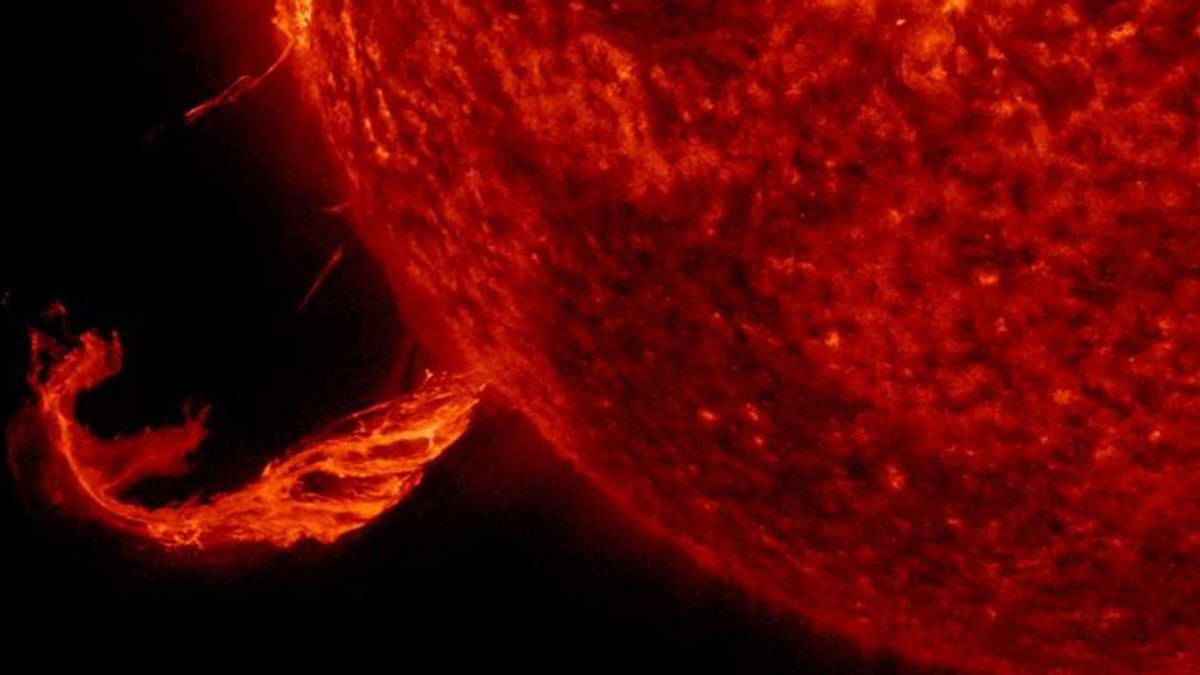JAKARTA - The sun, which is claimed to be very young, recently released an eruption of magnetic plasma gas 10 times larger. Scientists say this explosion could serve as a warning to Earth.
According to scientists, the explosion was also larger than ever seen from a Sun-like star. The exploding star, dubbed EK Draconis, is only about 100 million years old, which means it looks like the Sun and Earth about 4.5 billion years ago.
Study leader Yuta Notsu, and a researcher at the Laboratory for Atmospheric and Space Physics at the University of Colorado, in his findings suggests the Sun is capable of spitting out Coronal Mass Ejections (CMEs) or plasma gas bubbles much larger than those observed directly so far.
"However, because the Sun is older than EK Draconis, it tends to be quieter, with very large CMEs occurring less and farther between the two," said Notsu in findings published in the journal Nature Astronomy, September 9.
Notsu added that understanding the upper limit of the CME is important, because these energetic magnetic eruptions can interact with Earth's atmosphere, and have the potential to cause geomagnetic storms that can disrupt satellites, cause power outages, disrupt the internet and other communications on Earth.
Quoting Live Science, Tuesday, December 14, even CME is also a potential danger for manned missions to the Moon or Mars. Because these solar storms send out streams of high-energy particles that can expose anyone outside of Earth's protective magnetic shield to as much as 300,000 X-rays at once. This is a fatal dose, NASA said.
Previously, Notsu and his colleagues reported in 2019 that Sun-like stars are capable of producing large bursts of electromagnetic radiation called super flares. Scientists found that young stars like the Sun put out super flares every week, whereas older stars like the Sun and Earth rarely did, perhaps every 1,000 years or so.
Super flares like these are actually harmless bursts of electromagnetic radiation. But some of the proportions of super flares followed by major CMEs can be dangerous. So Notsu and his team turned to EK Draconis to find out if super flares trigger large CMEs in young stars like the Sun.
Using NASA's Transiting Exoplanet Survey Satellite (TESS) and Kyoto University's SEIMEI Telescope, the scientists peered through space 111 light-years away to observe the star between January and April 2020.
On April 5, they found what they were looking for, such as a shift in the spectrum of light emitted by the star, indicating a plume of plasma moving toward Earth. The eruption was traveling at about 1 million mph (1.6 million km/h) and had a mass of more than 2 quadrillion pounds (1 quadrillion kilograms), 10 times the observed mass of the Sun flare.
"This is very helpful for estimating the possibility of a CME with a super flare on our Sun," said Notsu.
EK Draconis' new observations capture only the first phase of the CME. Scientists are still not sure how many super flares end up in CMEs and how many lessen without plasma explosions.
"More observations with different instruments can give the bigger picture," said Notsu.
Studying sun-like stars in their youth goes beyond just preparing for potential disaster. It is also an avenue for peeking a window into our own Solar System's past. For example, scientists believe that Mars may once have had a thick atmosphere like Earth's.
One hypothesis once suggested that when Mars lost its magnetic field, high-energy particles from the Sun began to erode in this atmosphere, eventually leaving the planet barren and unprotected. Although, little is known about the interactions between the Sun and the planets in the early Solar System, those interactions may have been very different from what is observed today.
"We need more collaboration with planetary scientists to estimate more detailed effects on the planet," said Notsu.
The English, Chinese, Japanese, Arabic, and French versions are automatically generated by the AI. So there may still be inaccuracies in translating, please always see Indonesian as our main language. (system supported by DigitalSiber.id)













